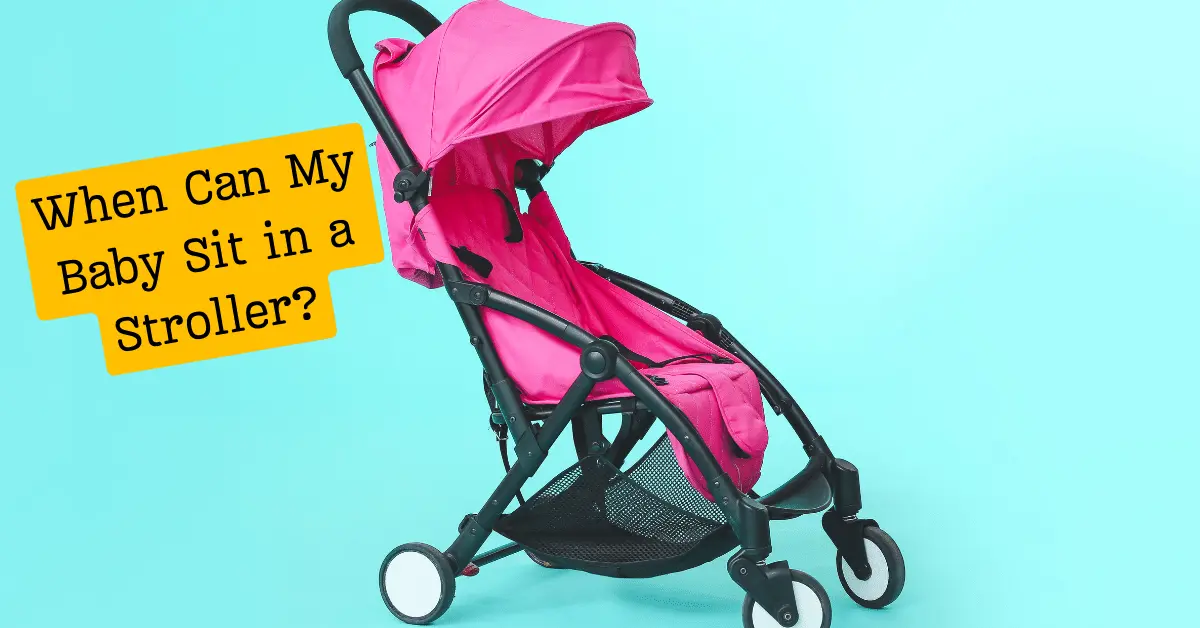When Can My Baby Sit in a Stroller?
As new parents, you experience numerous moments of happiness and eagerness, especially seeing your newborn grow through different developmental stages. Every milestone celebrates your baby’s unique personality development, from the first smiles to the captivating moments of self-discovery.
As your little one becomes more curious and interacts playfully with you, you may wonder When Can My Baby Sit in a Stroller? While there’s no one-size-fits-all answer, most experts recommend waiting until your baby can sit up unassisted, usually around six months, before introducing them to the stroller. This blog will explore the factors to consider when transitioning, focusing on strengthening your baby’s neck muscles and ensuring their safety during stroller rides. Let’s dive into this thrilling phase of your baby’s growth!
Importance of Good Head Control in Babies Before Sitting Upright in a Stroller

Babies are generally ready to transition from a bassinet, stroller, or car seat to a reclined front-facing stroller around three months. However, it’s essential to consider two critical developmental milestones before transitioning to a more upright stroller seat, typically around six months.
Before a baby can safely sit in a stroller, they must exhibit reasonable head control. This means holding their head steady without it flopping forward, backward, or to the sides. Head control is vital for various reasons:
- Ensures comfortable breathing in the stroller by preventing the head from slumping forward or the chin pressing against the chest, potentially blocking the airway.
- Helps the baby adjust their head position in response to movement, ensuring a comfortable and safe ride.
- Indicates that the baby’s neck and spine are strong enough to hold the head upright, reducing the risk of strain and injury.
Typically, babies achieve the milestone of reasonable head control around three to four months of age. Assessing your baby’s readiness based on these developmental milestones is essential rather than relying solely on their age. This approach ensures a safer and more comfortable experience for the baby when sitting up in a stroller.
How to Test For Adequate Head Control Before Switching to a Stroller

To assess your baby’s head control, place them on your lap with your hands gently supporting their rib cage. While providing support, observe their head movements and posture. A baby with reasonable head control will keep their head steady without shaking or wobbling. This steadiness indicates strong neck muscles, which reduces the risk of injury in a stroller. Ensure a visible gap between their chin and chest, as a resting chin could pose a suffocation risk.
Also, could you test if your baby can maintain a straight head position when gently moved from side to side? Keeping the head steady and aligned with the body’s center is crucial for sitting upright in a stroller.

Assessing Postural Balance
Postural balance is essential for your baby’s comfort and safety while sitting in a stroller. Leaning too much to one side can strain the neck, spine, and joints, potentially causing discomfort or long-term issues. It can also affect breathing and pose risks of entanglement and injury.
To observe your baby’s postural control, you can place them in a slightly reclined position in a bouncer seat or on your lap. Observe their posture, focusing on the alignment of the head, neck, and spine. A balanced, symmetrical position with proper alignment indicates reasonable postural control.
Please ensure your baby doesn’t lean excessively to one side while sitting upright. This will help them prepare to adapt to movements and bumps in the stroller, reducing the risk of falls or injuries.
By following these simple tests, you can ensure a safe and comfortable transition for your baby to sit up in a stroller.
How can you help your infant develop strong muscles?
To help your baby develop strong muscles, engaging them in activities such as tummy time is recommended. This involves laying your infant on their stomach while supervising closely and using a mirror, toy, or the presence of a parent to encourage them to lift their head. This practice helps strengthen their neck, back, and stomach muscles, a crucial step towards independent sitting. Although some babies might not like tummy time, you can make it more enjoyable by introducing developmental toys and gradually increasing the duration.
At about seven months, your baby may develop enough strength to sit up independently, a significant milestone. This paves the way for sitting upright in a stroller. Choose a stroller with multiple recline positions to accommodate their growing independence. Consider a modular stroller that allows you to switch between parent-facing and world-facing orientations, facilitating bonding with your baby and exploring the surrounding environment.
Determining when babies are safe to sit up in a stroller depends on their size and developmental stage rather than a specific age. During the early months, when their muscles are still developing, it is recommended that babies ride in a fully reclined position. The transition to a stroller seat should occur when they can support their head independently, usually around three months old. The shift to an upright position in the stroller seat is advisable when the baby can sit up alone, typically between five and seven months of age. Meanwhile, it’s crucial to promote the development of your baby’s gross motor skills to assist them in achieving significant milestones.
While babies can use a stroller from birth when paired with an infant car seat or a suitable model such as a bassinet stroller, their ability to sit up in the traditional stroller seat depends on head and neck control. Most importantly, the baby must be able to support their head without assistance, usually starting around six months old but varying among individuals.
Before placing the baby directly in a stroller, they should be able to control their head and neck and sit without support to prevent forward falls. It is crucial to ensure that the seat harness is correctly adjusted and that the baby is securely fastened to avoid any risk of the head tilting too far forward and compromising the airway. The seat recline should be adjusted for comfort.
Versatile stroller options, such as the Corso Modular Strollers, can transform into lightweight frame strollers by removing toddler seats and using an infant car seat. This versatility accommodates forward-facing or parent-facing preferences and facilitates a smooth transition to the stroller seat when the baby is ready.
When choosing a stroller for your baby, it’s crucial to consider various factors to ensure it meets your and your baby’s needs. Here are key considerations to guide you in picking the perfect stroller:
Age and Weight Limitations
Please make sure the stroller matches your baby’s age and weight. Some strollers have specific recommendations regarding when babies can support their head and neck. If your baby is under six months old or lacks sufficient head and neck strength, opt for a stroller that accommodates an infant car seat, bassinet, or fully reclining seat with a harness. Travel systems, including an infant car seat, base, and stroller, offer seamless transitions from car to stroller.
Portability and Maneuverability
Please look at the stroller’s portability and maneuverability, especially if you plan on various outings. Heavy strollers may be challenging to fold and navigate in tight spaces. Lightweight strollers, ideal for stairs and daily use, or frame strollers, used with an infant car seat for quick transitions, are practical options. For multitasking parents, strollers with one-hand bright fold designs, like the Bravo Quick-Fold 3-in-1 Strollers, provide convenience.
Wheels and Brakes
Pay attention to the stroller’s wheels and brakes. While all strollers meet federal brake test standards, you can choose between foot pedal brakes for hands-free operation or hand-operated parking brakes for open-toe shoes.
Consider the wheel design based on your usage — treaded tires for smooth rides or larger rubber wheels for jogging strollers adapting to varied terrain. Opt for a stroller with lockable front wheels for added convenience during trips.
Your Overall Lifestyle
Tailor your stroller choice to your lifestyle. If you’re active, use public transportation, or travel frequently, select a stroller that aligns with your needs. Ensure it’s easily foldable, fits your trunk, or can handle diverse terrains. Evaluate each stroller type’s benefits, considering ease of use, portability, and terrain adaptability.
By carefully considering these factors, you can make an informed decision and choose a stroller that seamlessly integrates into your daily life, providing comfort and convenience for you and your baby.
You may also like


Wonderful beat I wish to apprentice while you amend your web site how could i subscribe for a blog web site The account aided me a acceptable deal I had been a little bit acquainted of this your broadcast provided bright clear idea